Governance and Stakeholder Management Analysis: Perth Arena
VerifiedAdded on 2023/06/10
|7
|2446
|488
Report
AI Summary
This report analyzes the governance and stakeholder management failures of the Perth Athena Project, a multi-purpose sports and entertainment arena in Perth, Australia. The project, planned to start operations by 2012, faced significant issues due to inadequate governance structures, lack of asset management frameworks, poor project team setup, deficient record-keeping, and unclear agency responsibilities. The report identifies five key governance problems and proposes solutions for each, emphasizing the need for improved oversight, rigorous project approval processes, skilled project teams, meticulous record management, and clear delineation of responsibilities. A stakeholder circle illustrates the influence and power of various stakeholders, including the Expenditure Review Committee, Cabinet, and Consultants. The report then focuses on two key stakeholders, the Expenditure Review Committee and the Consultants, analyzing their interests, influence, and distance from the project. It suggests management strategies for these stakeholders, including mapping, influencing, identifying triggers, seeking opportunities, and proactive mitigation of risks. The conclusion highlights that the project's failure stemmed from misjudgments and a lack of foresight, and underscores the importance of effective governance and stakeholder management for successful project outcomes.
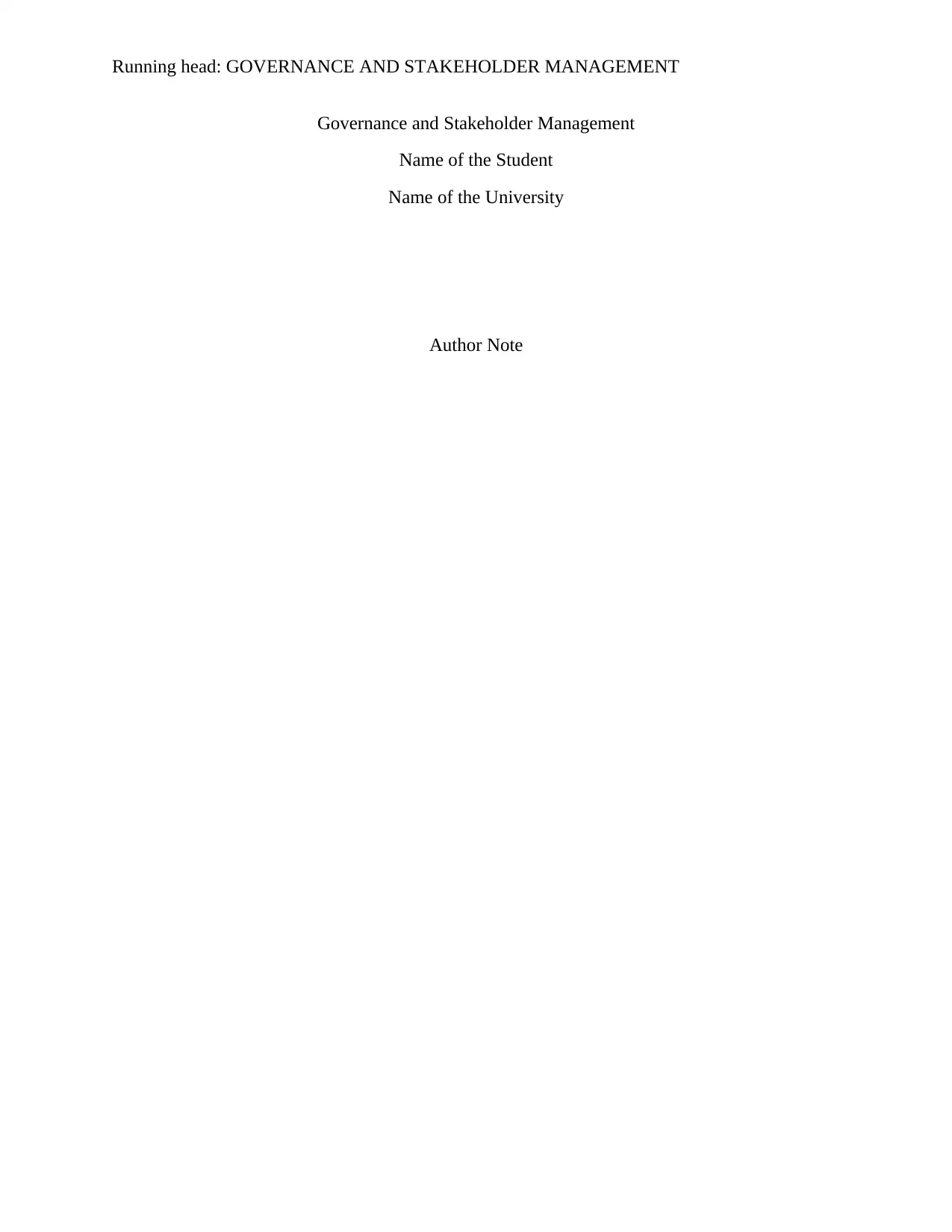
Running head: GOVERNANCE AND STAKEHOLDER MANAGEMENT
Governance and Stakeholder Management
Name of the Student
Name of the University
Author Note
Governance and Stakeholder Management
Name of the Student
Name of the University
Author Note
Paraphrase This Document
Need a fresh take? Get an instant paraphrase of this document with our AI Paraphraser
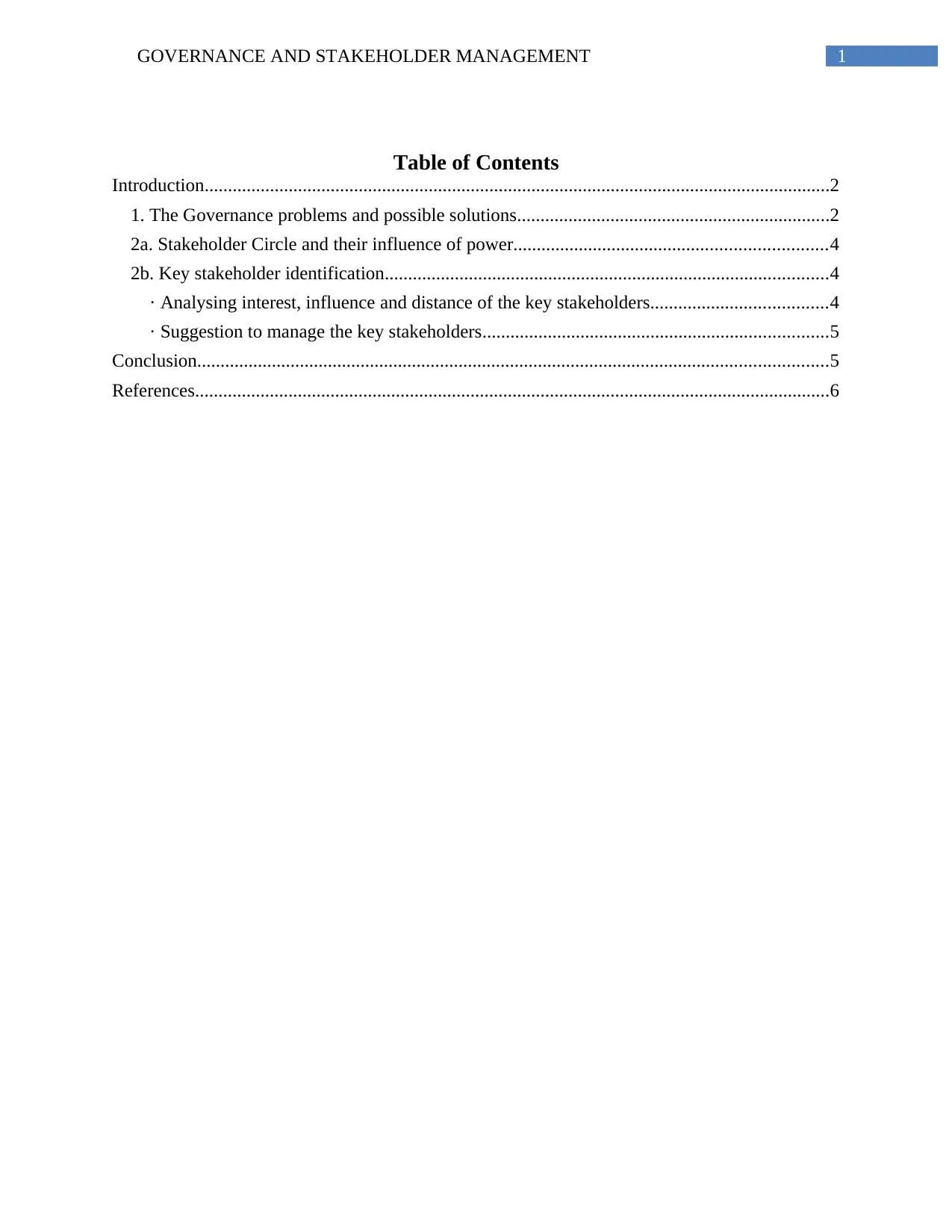
1GOVERNANCE AND STAKEHOLDER MANAGEMENT
Table of Contents
Introduction......................................................................................................................................2
1. The Governance problems and possible solutions...................................................................2
2a. Stakeholder Circle and their influence of power...................................................................4
2b. Key stakeholder identification...............................................................................................4
· Analysing interest, influence and distance of the key stakeholders......................................4
· Suggestion to manage the key stakeholders..........................................................................5
Conclusion.......................................................................................................................................5
References........................................................................................................................................6
Table of Contents
Introduction......................................................................................................................................2
1. The Governance problems and possible solutions...................................................................2
2a. Stakeholder Circle and their influence of power...................................................................4
2b. Key stakeholder identification...............................................................................................4
· Analysing interest, influence and distance of the key stakeholders......................................4
· Suggestion to manage the key stakeholders..........................................................................5
Conclusion.......................................................................................................................................5
References........................................................................................................................................6
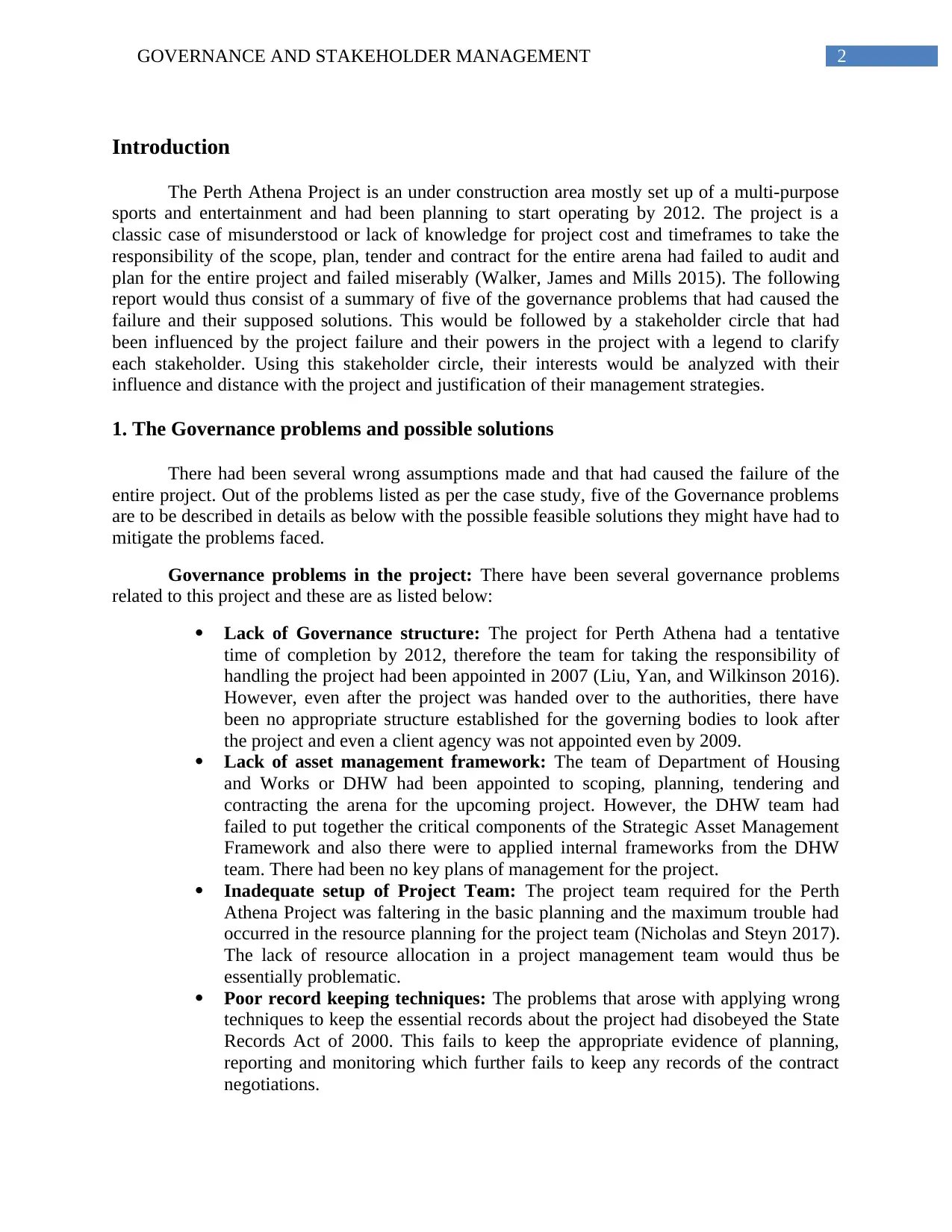
2GOVERNANCE AND STAKEHOLDER MANAGEMENT
Introduction
The Perth Athena Project is an under construction area mostly set up of a multi-purpose
sports and entertainment and had been planning to start operating by 2012. The project is a
classic case of misunderstood or lack of knowledge for project cost and timeframes to take the
responsibility of the scope, plan, tender and contract for the entire arena had failed to audit and
plan for the entire project and failed miserably (Walker, James and Mills 2015). The following
report would thus consist of a summary of five of the governance problems that had caused the
failure and their supposed solutions. This would be followed by a stakeholder circle that had
been influenced by the project failure and their powers in the project with a legend to clarify
each stakeholder. Using this stakeholder circle, their interests would be analyzed with their
influence and distance with the project and justification of their management strategies.
1. The Governance problems and possible solutions
There had been several wrong assumptions made and that had caused the failure of the
entire project. Out of the problems listed as per the case study, five of the Governance problems
are to be described in details as below with the possible feasible solutions they might have had to
mitigate the problems faced.
Governance problems in the project: There have been several governance problems
related to this project and these are as listed below:
Lack of Governance structure: The project for Perth Athena had a tentative
time of completion by 2012, therefore the team for taking the responsibility of
handling the project had been appointed in 2007 (Liu, Yan, and Wilkinson 2016).
However, even after the project was handed over to the authorities, there have
been no appropriate structure established for the governing bodies to look after
the project and even a client agency was not appointed even by 2009.
Lack of asset management framework: The team of Department of Housing
and Works or DHW had been appointed to scoping, planning, tendering and
contracting the arena for the upcoming project. However, the DHW team had
failed to put together the critical components of the Strategic Asset Management
Framework and also there were to applied internal frameworks from the DHW
team. There had been no key plans of management for the project.
Inadequate setup of Project Team: The project team required for the Perth
Athena Project was faltering in the basic planning and the maximum trouble had
occurred in the resource planning for the project team (Nicholas and Steyn 2017).
The lack of resource allocation in a project management team would thus be
essentially problematic.
Poor record keeping techniques: The problems that arose with applying wrong
techniques to keep the essential records about the project had disobeyed the State
Records Act of 2000. This fails to keep the appropriate evidence of planning,
reporting and monitoring which further fails to keep any records of the contract
negotiations.
Introduction
The Perth Athena Project is an under construction area mostly set up of a multi-purpose
sports and entertainment and had been planning to start operating by 2012. The project is a
classic case of misunderstood or lack of knowledge for project cost and timeframes to take the
responsibility of the scope, plan, tender and contract for the entire arena had failed to audit and
plan for the entire project and failed miserably (Walker, James and Mills 2015). The following
report would thus consist of a summary of five of the governance problems that had caused the
failure and their supposed solutions. This would be followed by a stakeholder circle that had
been influenced by the project failure and their powers in the project with a legend to clarify
each stakeholder. Using this stakeholder circle, their interests would be analyzed with their
influence and distance with the project and justification of their management strategies.
1. The Governance problems and possible solutions
There had been several wrong assumptions made and that had caused the failure of the
entire project. Out of the problems listed as per the case study, five of the Governance problems
are to be described in details as below with the possible feasible solutions they might have had to
mitigate the problems faced.
Governance problems in the project: There have been several governance problems
related to this project and these are as listed below:
Lack of Governance structure: The project for Perth Athena had a tentative
time of completion by 2012, therefore the team for taking the responsibility of
handling the project had been appointed in 2007 (Liu, Yan, and Wilkinson 2016).
However, even after the project was handed over to the authorities, there have
been no appropriate structure established for the governing bodies to look after
the project and even a client agency was not appointed even by 2009.
Lack of asset management framework: The team of Department of Housing
and Works or DHW had been appointed to scoping, planning, tendering and
contracting the arena for the upcoming project. However, the DHW team had
failed to put together the critical components of the Strategic Asset Management
Framework and also there were to applied internal frameworks from the DHW
team. There had been no key plans of management for the project.
Inadequate setup of Project Team: The project team required for the Perth
Athena Project was faltering in the basic planning and the maximum trouble had
occurred in the resource planning for the project team (Nicholas and Steyn 2017).
The lack of resource allocation in a project management team would thus be
essentially problematic.
Poor record keeping techniques: The problems that arose with applying wrong
techniques to keep the essential records about the project had disobeyed the State
Records Act of 2000. This fails to keep the appropriate evidence of planning,
reporting and monitoring which further fails to keep any records of the contract
negotiations.
⊘ This is a preview!⊘
Do you want full access?
Subscribe today to unlock all pages.

Trusted by 1+ million students worldwide
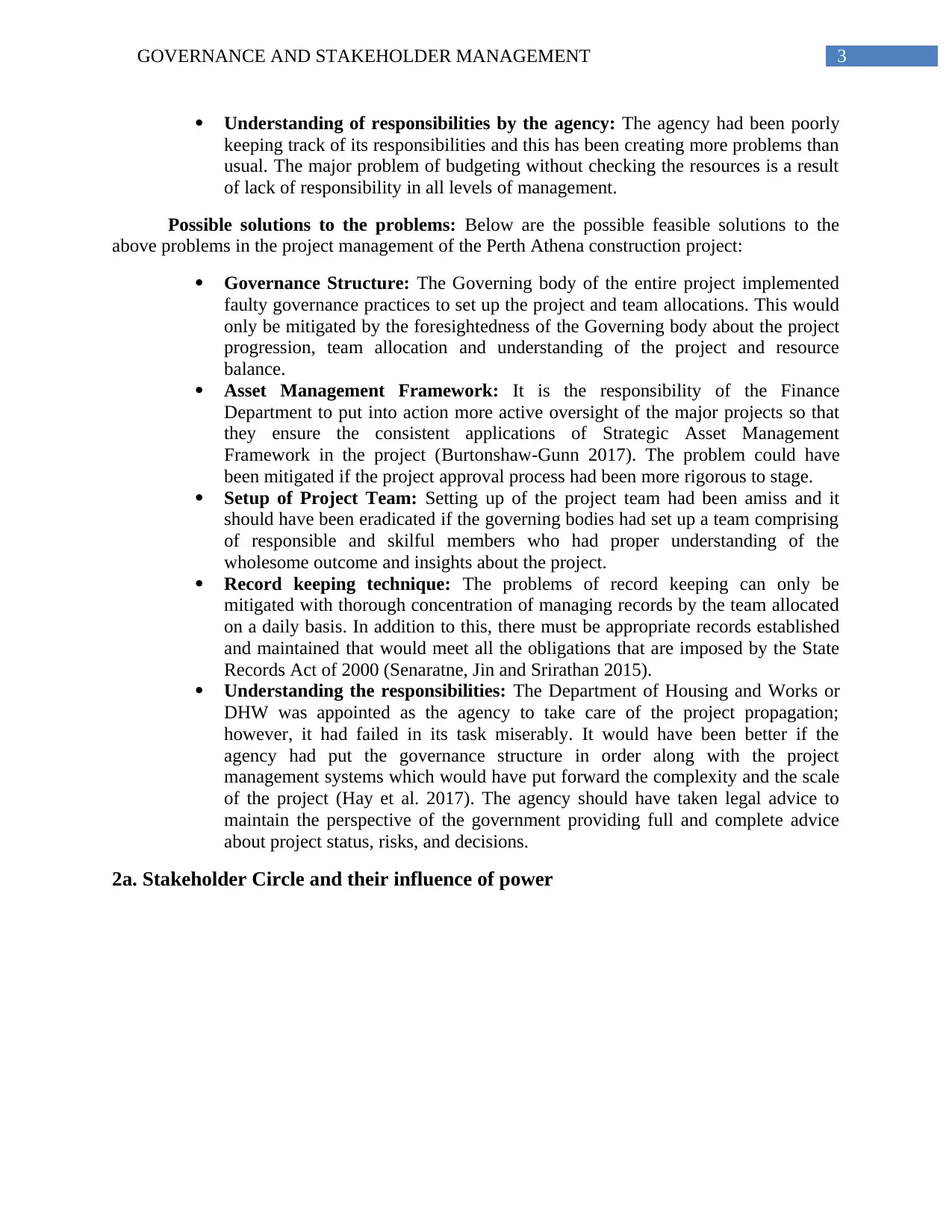
3GOVERNANCE AND STAKEHOLDER MANAGEMENT
Understanding of responsibilities by the agency: The agency had been poorly
keeping track of its responsibilities and this has been creating more problems than
usual. The major problem of budgeting without checking the resources is a result
of lack of responsibility in all levels of management.
Possible solutions to the problems: Below are the possible feasible solutions to the
above problems in the project management of the Perth Athena construction project:
Governance Structure: The Governing body of the entire project implemented
faulty governance practices to set up the project and team allocations. This would
only be mitigated by the foresightedness of the Governing body about the project
progression, team allocation and understanding of the project and resource
balance.
Asset Management Framework: It is the responsibility of the Finance
Department to put into action more active oversight of the major projects so that
they ensure the consistent applications of Strategic Asset Management
Framework in the project (Burtonshaw-Gunn 2017). The problem could have
been mitigated if the project approval process had been more rigorous to stage.
Setup of Project Team: Setting up of the project team had been amiss and it
should have been eradicated if the governing bodies had set up a team comprising
of responsible and skilful members who had proper understanding of the
wholesome outcome and insights about the project.
Record keeping technique: The problems of record keeping can only be
mitigated with thorough concentration of managing records by the team allocated
on a daily basis. In addition to this, there must be appropriate records established
and maintained that would meet all the obligations that are imposed by the State
Records Act of 2000 (Senaratne, Jin and Srirathan 2015).
Understanding the responsibilities: The Department of Housing and Works or
DHW was appointed as the agency to take care of the project propagation;
however, it had failed in its task miserably. It would have been better if the
agency had put the governance structure in order along with the project
management systems which would have put forward the complexity and the scale
of the project (Hay et al. 2017). The agency should have taken legal advice to
maintain the perspective of the government providing full and complete advice
about project status, risks, and decisions.
2a. Stakeholder Circle and their influence of power
Understanding of responsibilities by the agency: The agency had been poorly
keeping track of its responsibilities and this has been creating more problems than
usual. The major problem of budgeting without checking the resources is a result
of lack of responsibility in all levels of management.
Possible solutions to the problems: Below are the possible feasible solutions to the
above problems in the project management of the Perth Athena construction project:
Governance Structure: The Governing body of the entire project implemented
faulty governance practices to set up the project and team allocations. This would
only be mitigated by the foresightedness of the Governing body about the project
progression, team allocation and understanding of the project and resource
balance.
Asset Management Framework: It is the responsibility of the Finance
Department to put into action more active oversight of the major projects so that
they ensure the consistent applications of Strategic Asset Management
Framework in the project (Burtonshaw-Gunn 2017). The problem could have
been mitigated if the project approval process had been more rigorous to stage.
Setup of Project Team: Setting up of the project team had been amiss and it
should have been eradicated if the governing bodies had set up a team comprising
of responsible and skilful members who had proper understanding of the
wholesome outcome and insights about the project.
Record keeping technique: The problems of record keeping can only be
mitigated with thorough concentration of managing records by the team allocated
on a daily basis. In addition to this, there must be appropriate records established
and maintained that would meet all the obligations that are imposed by the State
Records Act of 2000 (Senaratne, Jin and Srirathan 2015).
Understanding the responsibilities: The Department of Housing and Works or
DHW was appointed as the agency to take care of the project propagation;
however, it had failed in its task miserably. It would have been better if the
agency had put the governance structure in order along with the project
management systems which would have put forward the complexity and the scale
of the project (Hay et al. 2017). The agency should have taken legal advice to
maintain the perspective of the government providing full and complete advice
about project status, risks, and decisions.
2a. Stakeholder Circle and their influence of power
Paraphrase This Document
Need a fresh take? Get an instant paraphrase of this document with our AI Paraphraser
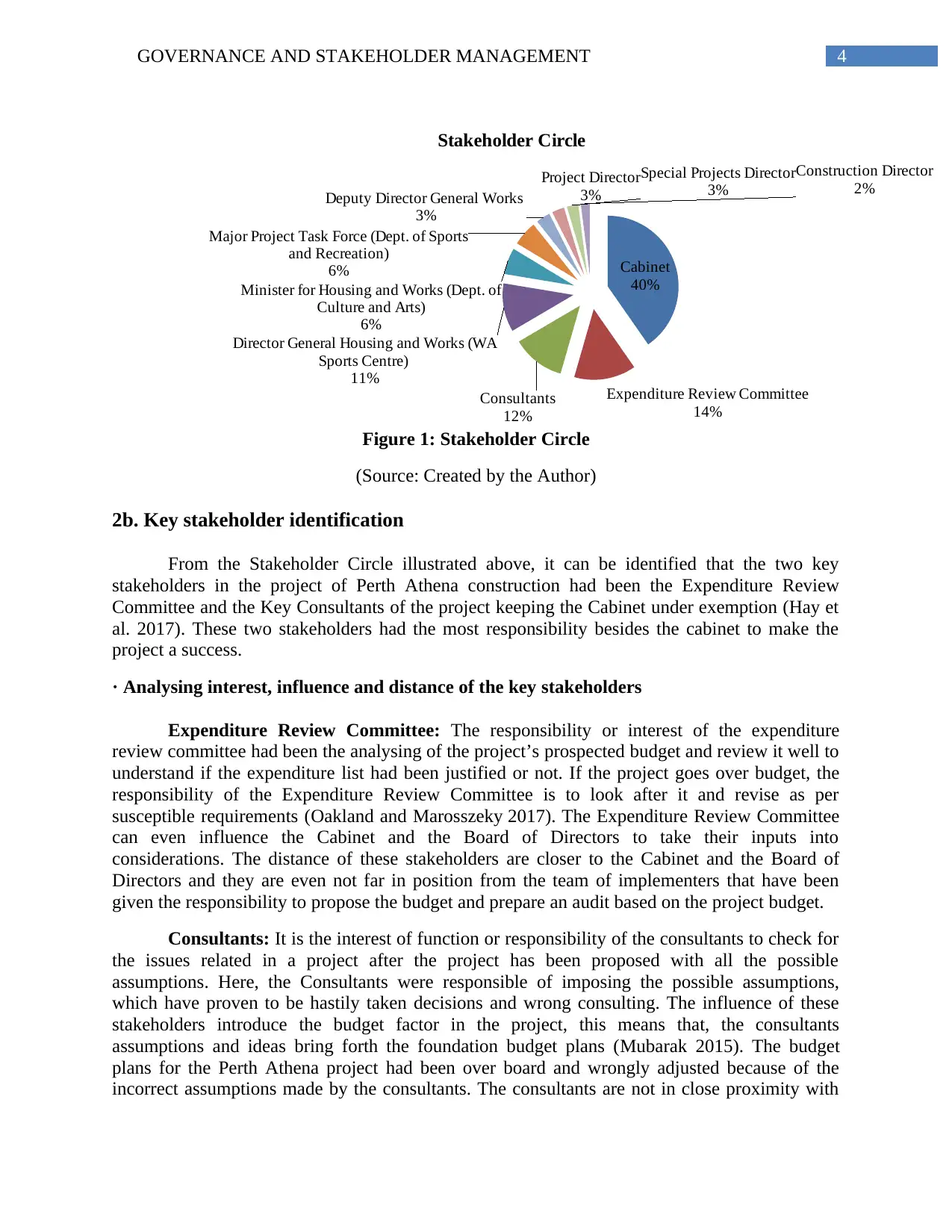
4GOVERNANCE AND STAKEHOLDER MANAGEMENT
Figure 1: Stakeholder Circle
(Source: Created by the Author)
2b. Key stakeholder identification
From the Stakeholder Circle illustrated above, it can be identified that the two key
stakeholders in the project of Perth Athena construction had been the Expenditure Review
Committee and the Key Consultants of the project keeping the Cabinet under exemption (Hay et
al. 2017). These two stakeholders had the most responsibility besides the cabinet to make the
project a success.
· Analysing interest, influence and distance of the key stakeholders
Expenditure Review Committee: The responsibility or interest of the expenditure
review committee had been the analysing of the project’s prospected budget and review it well to
understand if the expenditure list had been justified or not. If the project goes over budget, the
responsibility of the Expenditure Review Committee is to look after it and revise as per
susceptible requirements (Oakland and Marosszeky 2017). The Expenditure Review Committee
can even influence the Cabinet and the Board of Directors to take their inputs into
considerations. The distance of these stakeholders are closer to the Cabinet and the Board of
Directors and they are even not far in position from the team of implementers that have been
given the responsibility to propose the budget and prepare an audit based on the project budget.
Consultants: It is the interest of function or responsibility of the consultants to check for
the issues related in a project after the project has been proposed with all the possible
assumptions. Here, the Consultants were responsible of imposing the possible assumptions,
which have proven to be hastily taken decisions and wrong consulting. The influence of these
stakeholders introduce the budget factor in the project, this means that, the consultants
assumptions and ideas bring forth the foundation budget plans (Mubarak 2015). The budget
plans for the Perth Athena project had been over board and wrongly adjusted because of the
incorrect assumptions made by the consultants. The consultants are not in close proximity with
Cabinet
40%
Expenditure Review Committee
14%
Consultants
12%
Director General Housing and Works (WA
Sports Centre)
11%
Minister for Housing and Works (Dept. of
Culture and Arts)
6%
Major Project Task Force (Dept. of Sports
and Recreation)
6%
Deputy Director General Works
3%
Project Director
3%
Special Projects Director
3%
Construction Director
2%
Stakeholder Circle
Figure 1: Stakeholder Circle
(Source: Created by the Author)
2b. Key stakeholder identification
From the Stakeholder Circle illustrated above, it can be identified that the two key
stakeholders in the project of Perth Athena construction had been the Expenditure Review
Committee and the Key Consultants of the project keeping the Cabinet under exemption (Hay et
al. 2017). These two stakeholders had the most responsibility besides the cabinet to make the
project a success.
· Analysing interest, influence and distance of the key stakeholders
Expenditure Review Committee: The responsibility or interest of the expenditure
review committee had been the analysing of the project’s prospected budget and review it well to
understand if the expenditure list had been justified or not. If the project goes over budget, the
responsibility of the Expenditure Review Committee is to look after it and revise as per
susceptible requirements (Oakland and Marosszeky 2017). The Expenditure Review Committee
can even influence the Cabinet and the Board of Directors to take their inputs into
considerations. The distance of these stakeholders are closer to the Cabinet and the Board of
Directors and they are even not far in position from the team of implementers that have been
given the responsibility to propose the budget and prepare an audit based on the project budget.
Consultants: It is the interest of function or responsibility of the consultants to check for
the issues related in a project after the project has been proposed with all the possible
assumptions. Here, the Consultants were responsible of imposing the possible assumptions,
which have proven to be hastily taken decisions and wrong consulting. The influence of these
stakeholders introduce the budget factor in the project, this means that, the consultants
assumptions and ideas bring forth the foundation budget plans (Mubarak 2015). The budget
plans for the Perth Athena project had been over board and wrongly adjusted because of the
incorrect assumptions made by the consultants. The consultants are not in close proximity with
Cabinet
40%
Expenditure Review Committee
14%
Consultants
12%
Director General Housing and Works (WA
Sports Centre)
11%
Minister for Housing and Works (Dept. of
Culture and Arts)
6%
Major Project Task Force (Dept. of Sports
and Recreation)
6%
Deputy Director General Works
3%
Project Director
3%
Special Projects Director
3%
Construction Director
2%
Stakeholder Circle
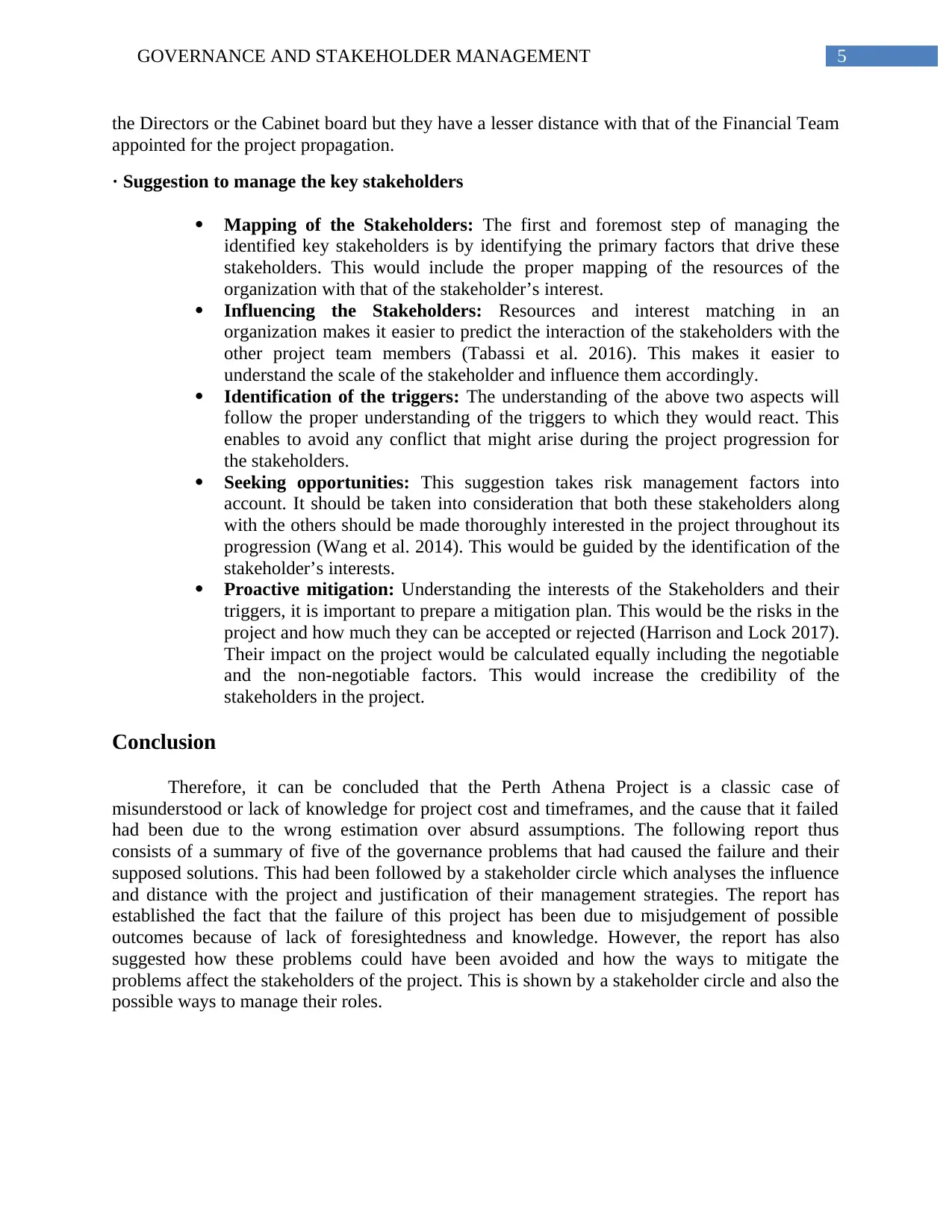
5GOVERNANCE AND STAKEHOLDER MANAGEMENT
the Directors or the Cabinet board but they have a lesser distance with that of the Financial Team
appointed for the project propagation.
· Suggestion to manage the key stakeholders
Mapping of the Stakeholders: The first and foremost step of managing the
identified key stakeholders is by identifying the primary factors that drive these
stakeholders. This would include the proper mapping of the resources of the
organization with that of the stakeholder’s interest.
Influencing the Stakeholders: Resources and interest matching in an
organization makes it easier to predict the interaction of the stakeholders with the
other project team members (Tabassi et al. 2016). This makes it easier to
understand the scale of the stakeholder and influence them accordingly.
Identification of the triggers: The understanding of the above two aspects will
follow the proper understanding of the triggers to which they would react. This
enables to avoid any conflict that might arise during the project progression for
the stakeholders.
Seeking opportunities: This suggestion takes risk management factors into
account. It should be taken into consideration that both these stakeholders along
with the others should be made thoroughly interested in the project throughout its
progression (Wang et al. 2014). This would be guided by the identification of the
stakeholder’s interests.
Proactive mitigation: Understanding the interests of the Stakeholders and their
triggers, it is important to prepare a mitigation plan. This would be the risks in the
project and how much they can be accepted or rejected (Harrison and Lock 2017).
Their impact on the project would be calculated equally including the negotiable
and the non-negotiable factors. This would increase the credibility of the
stakeholders in the project.
Conclusion
Therefore, it can be concluded that the Perth Athena Project is a classic case of
misunderstood or lack of knowledge for project cost and timeframes, and the cause that it failed
had been due to the wrong estimation over absurd assumptions. The following report thus
consists of a summary of five of the governance problems that had caused the failure and their
supposed solutions. This had been followed by a stakeholder circle which analyses the influence
and distance with the project and justification of their management strategies. The report has
established the fact that the failure of this project has been due to misjudgement of possible
outcomes because of lack of foresightedness and knowledge. However, the report has also
suggested how these problems could have been avoided and how the ways to mitigate the
problems affect the stakeholders of the project. This is shown by a stakeholder circle and also the
possible ways to manage their roles.
the Directors or the Cabinet board but they have a lesser distance with that of the Financial Team
appointed for the project propagation.
· Suggestion to manage the key stakeholders
Mapping of the Stakeholders: The first and foremost step of managing the
identified key stakeholders is by identifying the primary factors that drive these
stakeholders. This would include the proper mapping of the resources of the
organization with that of the stakeholder’s interest.
Influencing the Stakeholders: Resources and interest matching in an
organization makes it easier to predict the interaction of the stakeholders with the
other project team members (Tabassi et al. 2016). This makes it easier to
understand the scale of the stakeholder and influence them accordingly.
Identification of the triggers: The understanding of the above two aspects will
follow the proper understanding of the triggers to which they would react. This
enables to avoid any conflict that might arise during the project progression for
the stakeholders.
Seeking opportunities: This suggestion takes risk management factors into
account. It should be taken into consideration that both these stakeholders along
with the others should be made thoroughly interested in the project throughout its
progression (Wang et al. 2014). This would be guided by the identification of the
stakeholder’s interests.
Proactive mitigation: Understanding the interests of the Stakeholders and their
triggers, it is important to prepare a mitigation plan. This would be the risks in the
project and how much they can be accepted or rejected (Harrison and Lock 2017).
Their impact on the project would be calculated equally including the negotiable
and the non-negotiable factors. This would increase the credibility of the
stakeholders in the project.
Conclusion
Therefore, it can be concluded that the Perth Athena Project is a classic case of
misunderstood or lack of knowledge for project cost and timeframes, and the cause that it failed
had been due to the wrong estimation over absurd assumptions. The following report thus
consists of a summary of five of the governance problems that had caused the failure and their
supposed solutions. This had been followed by a stakeholder circle which analyses the influence
and distance with the project and justification of their management strategies. The report has
established the fact that the failure of this project has been due to misjudgement of possible
outcomes because of lack of foresightedness and knowledge. However, the report has also
suggested how these problems could have been avoided and how the ways to mitigate the
problems affect the stakeholders of the project. This is shown by a stakeholder circle and also the
possible ways to manage their roles.
⊘ This is a preview!⊘
Do you want full access?
Subscribe today to unlock all pages.

Trusted by 1+ million students worldwide
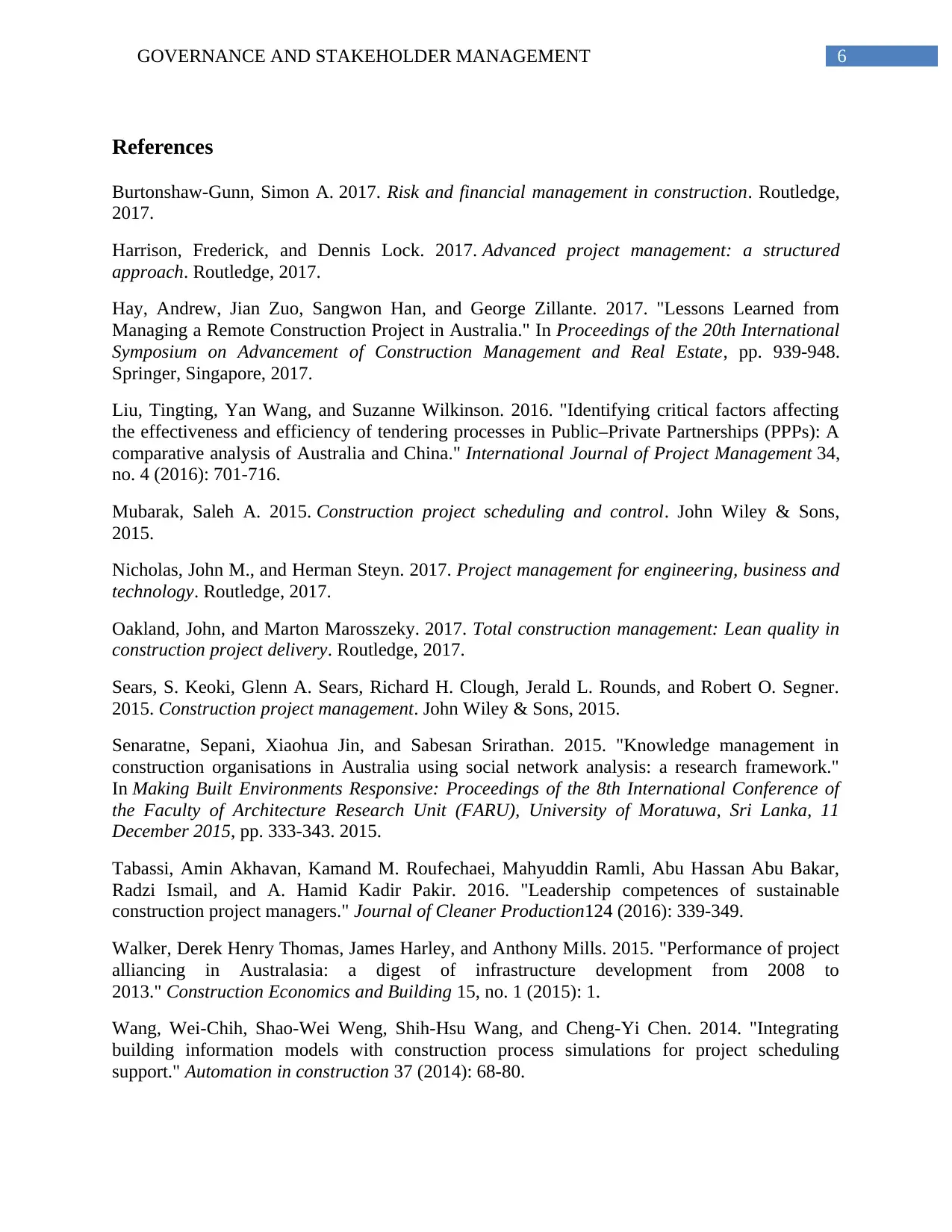
6GOVERNANCE AND STAKEHOLDER MANAGEMENT
References
Burtonshaw-Gunn, Simon A. 2017. Risk and financial management in construction. Routledge,
2017.
Harrison, Frederick, and Dennis Lock. 2017. Advanced project management: a structured
approach. Routledge, 2017.
Hay, Andrew, Jian Zuo, Sangwon Han, and George Zillante. 2017. "Lessons Learned from
Managing a Remote Construction Project in Australia." In Proceedings of the 20th International
Symposium on Advancement of Construction Management and Real Estate, pp. 939-948.
Springer, Singapore, 2017.
Liu, Tingting, Yan Wang, and Suzanne Wilkinson. 2016. "Identifying critical factors affecting
the effectiveness and efficiency of tendering processes in Public–Private Partnerships (PPPs): A
comparative analysis of Australia and China." International Journal of Project Management 34,
no. 4 (2016): 701-716.
Mubarak, Saleh A. 2015. Construction project scheduling and control. John Wiley & Sons,
2015.
Nicholas, John M., and Herman Steyn. 2017. Project management for engineering, business and
technology. Routledge, 2017.
Oakland, John, and Marton Marosszeky. 2017. Total construction management: Lean quality in
construction project delivery. Routledge, 2017.
Sears, S. Keoki, Glenn A. Sears, Richard H. Clough, Jerald L. Rounds, and Robert O. Segner.
2015. Construction project management. John Wiley & Sons, 2015.
Senaratne, Sepani, Xiaohua Jin, and Sabesan Srirathan. 2015. "Knowledge management in
construction organisations in Australia using social network analysis: a research framework."
In Making Built Environments Responsive: Proceedings of the 8th International Conference of
the Faculty of Architecture Research Unit (FARU), University of Moratuwa, Sri Lanka, 11
December 2015, pp. 333-343. 2015.
Tabassi, Amin Akhavan, Kamand M. Roufechaei, Mahyuddin Ramli, Abu Hassan Abu Bakar,
Radzi Ismail, and A. Hamid Kadir Pakir. 2016. "Leadership competences of sustainable
construction project managers." Journal of Cleaner Production124 (2016): 339-349.
Walker, Derek Henry Thomas, James Harley, and Anthony Mills. 2015. "Performance of project
alliancing in Australasia: a digest of infrastructure development from 2008 to
2013." Construction Economics and Building 15, no. 1 (2015): 1.
Wang, Wei-Chih, Shao-Wei Weng, Shih-Hsu Wang, and Cheng-Yi Chen. 2014. "Integrating
building information models with construction process simulations for project scheduling
support." Automation in construction 37 (2014): 68-80.
References
Burtonshaw-Gunn, Simon A. 2017. Risk and financial management in construction. Routledge,
2017.
Harrison, Frederick, and Dennis Lock. 2017. Advanced project management: a structured
approach. Routledge, 2017.
Hay, Andrew, Jian Zuo, Sangwon Han, and George Zillante. 2017. "Lessons Learned from
Managing a Remote Construction Project in Australia." In Proceedings of the 20th International
Symposium on Advancement of Construction Management and Real Estate, pp. 939-948.
Springer, Singapore, 2017.
Liu, Tingting, Yan Wang, and Suzanne Wilkinson. 2016. "Identifying critical factors affecting
the effectiveness and efficiency of tendering processes in Public–Private Partnerships (PPPs): A
comparative analysis of Australia and China." International Journal of Project Management 34,
no. 4 (2016): 701-716.
Mubarak, Saleh A. 2015. Construction project scheduling and control. John Wiley & Sons,
2015.
Nicholas, John M., and Herman Steyn. 2017. Project management for engineering, business and
technology. Routledge, 2017.
Oakland, John, and Marton Marosszeky. 2017. Total construction management: Lean quality in
construction project delivery. Routledge, 2017.
Sears, S. Keoki, Glenn A. Sears, Richard H. Clough, Jerald L. Rounds, and Robert O. Segner.
2015. Construction project management. John Wiley & Sons, 2015.
Senaratne, Sepani, Xiaohua Jin, and Sabesan Srirathan. 2015. "Knowledge management in
construction organisations in Australia using social network analysis: a research framework."
In Making Built Environments Responsive: Proceedings of the 8th International Conference of
the Faculty of Architecture Research Unit (FARU), University of Moratuwa, Sri Lanka, 11
December 2015, pp. 333-343. 2015.
Tabassi, Amin Akhavan, Kamand M. Roufechaei, Mahyuddin Ramli, Abu Hassan Abu Bakar,
Radzi Ismail, and A. Hamid Kadir Pakir. 2016. "Leadership competences of sustainable
construction project managers." Journal of Cleaner Production124 (2016): 339-349.
Walker, Derek Henry Thomas, James Harley, and Anthony Mills. 2015. "Performance of project
alliancing in Australasia: a digest of infrastructure development from 2008 to
2013." Construction Economics and Building 15, no. 1 (2015): 1.
Wang, Wei-Chih, Shao-Wei Weng, Shih-Hsu Wang, and Cheng-Yi Chen. 2014. "Integrating
building information models with construction process simulations for project scheduling
support." Automation in construction 37 (2014): 68-80.
1 out of 7
Related Documents
Your All-in-One AI-Powered Toolkit for Academic Success.
+13062052269
info@desklib.com
Available 24*7 on WhatsApp / Email
![[object Object]](/_next/static/media/star-bottom.7253800d.svg)
Unlock your academic potential
Copyright © 2020–2025 A2Z Services. All Rights Reserved. Developed and managed by ZUCOL.





